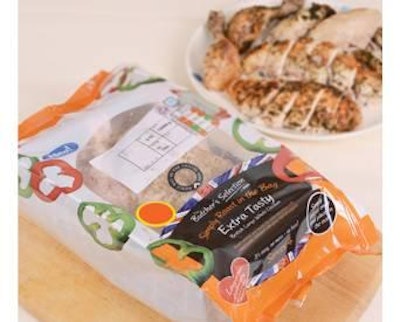
Campylobacter and its reduction are concerns for poultry producers around the world. This is little surprise, given that the pathogen has become the most common cause of bacterial food poisoning worldwide.
Campylobacter took center stage in the U.K. toward the end of last year after publication of an audit of retailers.
As 2014 drew to a close, the U.K.’s Food Standards Agency (FSA) named and shamed supermarkets and their suppliers over Campylobacter contamination levels of poultry meat. The press quickly picked up the story, publishing details of the number of people infected each year and broadcasting interviews with those affected by Guillain-Barre syndrome. There were even calls for consumers to boycott chicken sold by supermarkets.
Variety of approaches to control
There is nothing new about Campylobacter, or the industry’s efforts around the world to bring it under control.
New Zealand, for example, mandated Campylobacter targets in 2006, and producers globally have adopted approaches to bring levels down either on farm, at the processing plant, or by using a combination of both. Progress, however, has been difficult.
While late November 2014 saw the U.K. media spotlight fall on Campylobacter, the industry spotlight has been on the bacterium for much longer.
In response to the FSA publication, the British Poultry Council noted that its members had looked at every part of the production chain. Improved farm biosecurity, new slaughterhouse methods, and new technologies, such as the steam and ultrasound carcass treatment SonoSteam and rapid surface chilling, were all being examined, it said.
Roast-in-the-bag packaging was also referenced by the BPC as a way of preventing consumers coming into contact with Campylobacter, and while this packaging may primarily have been developed for consumer convenience rather than health, it is now increasingly being seen as a way of helping to ensure food safety in the home.
Major retail chain Asda, the U.K.’s second-largest supermarket chain by market share, launched whole chickens in oven-ready packaging in the U.K. in late 2013 branded as Butcher’s Selection Simply Roast in the Bag, and since then the product has won a string of awards nationally and internationally, and the packaging has been rolled out to other meats.
The consumer does not come into direct contact with the bird until it has been cooked, meaning that, should Campylobacter be present, it will be destroyed by the time the bird is directly handled.
The oven-ready, packaged bird came about as the result of Asda asking its supplier Faccenda Group to come up with an innovative product. Faccenda, in turn, worked with packaging company FFP.
The packaging features a flow-wrap, horizontal form fill seal solution, and is marketed as part of FFP’s Estercook range. While for Faccenda, one of the largest poultry suppliers in the U.K., the packaging may be more expensive, it has, nevertheless been economically viable, an important consideration for poultry processors in the U.K. given that, and in the wake of the FSA publication, retailers stressed that any additional costs associated with oven-ready packaging would not be passed on to consumers.
The product launch was supported by Asda through TV and print advertising, together with a “how-to” video on social media.
Packaging evolution
Direct-to-oven packaging has been available for a long time and, since the 1980s, has become increasingly visible in supermarkets, primarily for ready-to-eat meals, largely packed into crystalline polyethylene terephthalate trays, protected by heat-sealed polyester topweb lidding film. The same polyester film has been applied to several other types of convenience foods.
It became clear some years ago, FFP says, that there would be significant opportunities if the technical challenges of packaging whole birds for the oven could be overcome, and several packaging companies in various markets have come up with their own solutions.
The company notes that providing a barrier against the spread of Campylobacter and other pathogens was not its main consideration when working with Faccenda, rather the new packaging was presented as being “no mess, no touch, no fuss,” and the barrier property of the packaging was much more to do with the opportunity for the consumer to avoid having to handle raw meat, something some people find unpleasant. In addition to being heat resistant, polyester used for Butcher’s Selection is optically very clear and can be printed to high standards.
Oven-ready packaging also allows flavors to be added to the bird and sealed in and, because packaging traps moisture, the cooked bird remains moist and succulent. If the consumer cuts the bag open 20 minutes or so before the end of cooking, the chicken can be crisped.
Multi-benefit
FFP is not alone in developing oven-ready packaging, nor Asda the only retailer to recognize the approach’s benefits in attracting consumers with heightened food hygiene concerns given the recent focus on Campylobacter.
For example, also in 2013, Sirane launched its nylon roasting bags and a machine able to bag 40 birds per minute, pointing to the robustness of nylon as a material and to its absorbency characteristics for fat. Last year, Linpack Packaging, Rovipak and Parkside Flexibles Group joined forces and launched Quattrapak, a tiered packaging solution which includes a barrier oven-ready pack.
The retail landscape for whole fresh birds in the U.K. is changing. Roast-in-the-bag packaging had already been adopted by 30 percent of the market, even before the Co-operative and Marks & Spencer announced that they would move to 100 percent roast-in-bag packaging.
In November last year, shortly before the FSA publication, Marks & Spencer announced that its largest chicken supplier had been double bagging whole chickens so that they could be placed straight into the oven without the need to unwrap and handle since the end of September and, by year-end, all its suppliers would do the same. This, it noted, was part of the company’s five-point plan to tackle Campylobacter.


















